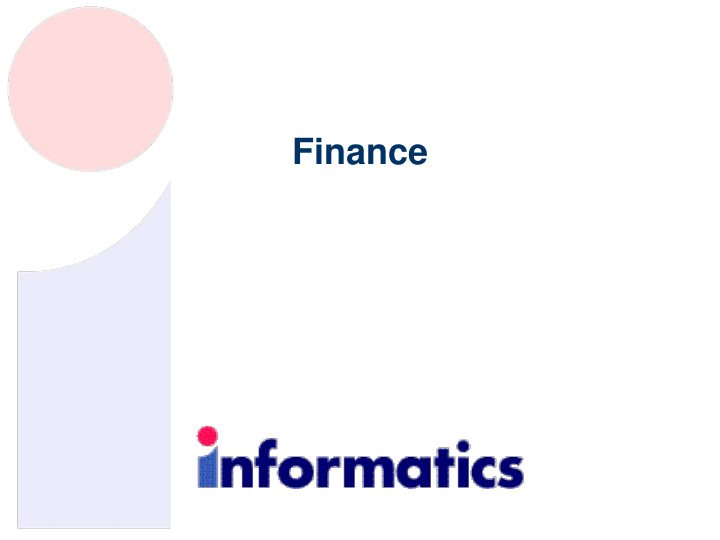



Finance
Summary Material in this slide set is closely based on the following chapters in Bott (you should read these chapters): – Ch 5: Financing a start-up – Ch 6: Financial Accounting – Ch 7: Management Accounting The goal of the session is to explore: – The role of money in enterprises – Different perspectives on finance in enterprises 21/04/2010 Professional Issues: Meeting 3 2 Money
The role of capital in startups Activity: Get into a group of 4 – Imagine you want to create a startup company – try to fix on something reasonably concrete. The answer the following questions (write down the answers): • For what purposes might your company need working capital? • What would you need to convince people to give you money? • What sources of funding do you think would be relevant? • What are the advantages and disadvantages of different sources? – S hare your answers with another group of four – Revise your answers in the light of your discussion 21/04/2010 Professional Issues: Meeting 3 3 Money
Startups Reasons: for a very wide range of purposes (e.g. wages, premises, equipment, advertising, marketing, travel, paying interest on loans) to let you effectively make, market and sell your initial product range – see the handout. What you need: A business plan: – What you are planning to sell, feasibility of the proj ect – Assessment of the Market size and how much you are likely to capture – Financial predictions: proj ected budgets, cash flows, profit and loss accounts and balance sheets S ources: Grants, Loans, Equity capital Issues: Gearing of the company – relationship between equity capital and loans – undesirable to be too highly geared. 21/04/2010 Professional Issues: Meeting 3 4 Money
Financial Accounting – Balance Sheets Activity: in your group of 4 people (you can ask any questions about the accounts you are looking at and I’ ll try to answer): – Does a balance sheet tell you? – What is an intangible asset? – What is the difference between current and non-current assets? – What line gets changed to make the sheet balance? – If the balance sheet did not include an Equity section what kind of company would we be looking at? – Take 5 minutes to assess how well you think the company is doing – write down a short j ustification for your assessment. 21/04/2010 Professional Issues: Meeting 3 5 Money
Financial Accounting: Profit and Loss/Income and Expense Activity, in your groups of four, look at the tables on p. 53 and answer the following questions: – Do you think 2008 was a good year for the company? Justify your answer. – What do you think note 3 refers to? – If you were a shareholder what would you think about this year’ s profit and loss statement. 21/04/2010 Professional Issues: Meeting 3 6 Money
Financial Accounting: Cash Flows Activity, in your group of 4, find one line in the statement of cash flows which is reasonably large and significantly different between 2008 and 2007: – Try to provide an explanation for the difference. – Do you think this is a good or a bad sign for the company? – Write down your answers 21/04/2010 Professional Issues: Meeting 3 7 Money
Financial Accounting The balance sheet, profit & loss statement and cash flow statement are the three key documents in financial accounting for a company. The balance sheet provides a snapshot of the assets and liabilites of the company on an annual basis. The profit & loss account shows the dynamics of trading across the year. The cash flow statement shows us all the other flows that are not income and expenditure: profit&loss, depreciation, return on investments, changes in long term loans, capital investment, taxation, acquisitions/ disposals, dividends, interest on loans, issue of new shares. 21/04/2010 Professional Issues: Meeting 3 8 Money
Summary All companies need money – even startups Financial accounting is aimed at making financial operations of companies transparent (even though some companies want to obscure their operations). The balance sheet, profit&loss statement and cash flow statement are the key elements of the financial statement. This form of accounting is a reporting tool, not a management tool. Next week we consider Management Accounting, Investment Appraisal and Proj ect management. 21/04/2010 Professional Issues: Meeting 3 9 Money
Recommend
More recommend